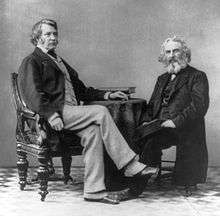Spats (footwear)

Spats, a shortening of spatterdashes, or spatter guards are a type of classic footwear accessory for outdoor wear, covering the instep and the ankle. Spats are distinct from gaiters, which are garments worn over the lower trouser leg as well as the shoe.
Civilian dress
Spats were primarily worn by men, and less commonly by women, in the late 19th and early 20th centuries. They fell out of frequent use during the 1920s. Made of white cloth, grey or brown felt material, spats buttoned around the ankle. Their intended practical purpose was to protect shoes and socks from mud or rain but this footwear also served as a feature of stylish dress in accordance with the fashions of the period.[1]
Increased informality may have been the primary reason for the decline in the wearing of spats. In 1913, friends scrambled to help Griffith Taylor find spats and a top hat to receive the King's Polar Medal from King George V.[2] In 1923 King George V opened the Chelsea Flower Show, an important event in the London Season, wearing a frock coat, gray top hat and spats. By 1926 the King shocked the public by wearing a black morning coat instead of a frock coat (a small but significant change). This arguably helped speed the Frock coat's demise (although it was still being worn on the eve of the Second World War). Spats were another clothing accessory left off by the King in 1926. Interestingly it is said that the moment this was observed and commented on by the spectators it produced an immediate reaction; the ground beneath the bushes was littered with discarded spats.[3]
From New York in 1936, the Associated Press observed that "in recent years well-dressed men have been discarding spats because they have become the property of the rank and file."[4] A revival of high-top shoes with cloth uppers was forecast to replace them.[4]
The third reason is probably the most significant, and the most prosaic—once western city streets became cleaner; due to the replacement of horses by cars and the use of asphalt and concrete—there simply was much less filth about and consequently much less need for "spatterdashes". Although some elderly men continued to wear them into the 1950s as part of their business garb, since the Second World War the wearing of Spats seems to have been confined to places like the Royal Enclosure at Ascot or very fancy private weddings.
Military uniform

Since the mid-19th century, soldiers of various nations, especially infantry, often wore leggings or spats to protect their lower leg, to keep dirt, sand, and mud from entering their shoes, and to provide a measure of ankle support. French infantry wore white spats for parade and off-duty wear until 1903. Italian soldiers wore a light tan version until 1910 and the Japanese Army wore long white spats or gaiters during the Russo-Japanese War of 1905.
Spats continue as a distinctive feature of the Scottish dress of Highland pipe bands, whether civilian or military. The modern Royal Regiment of Scotland, into which all Scottish line infantry regiments were amalgamated in 2006, retain white spats as part of their uniform. Prior to that date most Scottish infantry units in the British Army wore spats. For Highland regiments in kilts, spats reached halfway up the calf. For Lowland regiments in trews, spats were visible only over the brogue shoes.
Most regiments of the modern Indian and Pakistani Armies wear long white spats into which trousers are tucked, as part of their parade dress. Other full dress uniforms which still include spats are those of the Finnish Army, Swedish Army, Portuguese Republican National Guard, the Carabiniers of Monaco, the Egyptian Military Police and the Italian Military Academy of Modena. In the Finnish Navy, spats are part of the winter uniform. The U.S. Navy Honor Guard and Rifle Guard wear them while performing ceremonies.
Spats are still used as a traditional accessory in many marching band and drum and bugle corps uniforms in the United States.
Personal protective equipment
Spats remain in use today as personal protective equipment in certain industries. In foundries, pourers wear leather spats over their boots to protect against splashes of molten metal.[5] Even a small splash that lodges in a shoe or between the shoe and ankle could cause a severe burn. Many welders also wear fire-resistant spats for protection from sparks.[6] Casual chainsaw operators often wear protective spats over steel-toe boots,[7][8] but professionals are now encouraged to wear true chainsaw boots to prevent injury from accidental chainsaw contact with the foot or ankle.[7][9]
Symbolic use to represent wealth
The wearing of spats is often used as symbolic shorthand to represent wealth, eccentricity, or both. In some cases, these depictions occur long after spats ceased to be a normal part of everyday menswear but those from before the 1950s are usually making an allusion to "ordinary" upper-class standards of deportment and class. An example of this is Irving Berlin's song "Puttin' on the Ritz", which mentions spats along with a variety of other elements of formal clothing that were common when it was written.
The wearing of spats by fictional characters such as Agatha Christie's Hercule Poirot, P. G. Wodehouse's Bertie Wooster, Lord Peter Wimsey and Jean de Brunhoff's Babar the Elephant for example is mostly intended to underline the conventional nature of the characters involved. They are elegantly turned-out prosperous gentlemen of the period; it would be odd if they did not wear spats.
Rich Uncle Pennybags, the iconic man from the Monopoly board game, and Walt Disney's Scrooge McDuck are slightly more satirical, alluding to someone undeniably adept but possibly a bit stuck in the past. This is very similar to the obsessed scientist or absent-minded professor.
In a similar vein, in the film Some Like It Hot (made in the 1950s but set in the 1920s), the mob boss is called "Spats" Colombo, because he regularly wears spats, thus providing an ironic contrast between his aspirational gentility and his actual thuggish behavior. Similarly The Penguin from Batman is drawn wearing spats along with a suit with tails and in Who Framed Roger Rabbit Toon Patrol the chief weasel Smart Ass, also wears spats (probably a direct allusion to Spats Colombo).
Spats seem inappropriate on these creatures because they patently lack the genteel qualities that the presence of spats suggests. Together with white gloves and a monocle, spats are part of the symbolic shorthand to represent wealth, eccentricity, or both.
This is connected with the wearing of spats as a symbol of a drop in class. Here a man is trying to retain status in the face of declining circumstances; Charlie Chaplin's "little tramp" is an example of this as are several of W. C. Fields's characters, Burlington Bertie and Bustopher Jones from Old Possum's Book of Practical Cats by T. S. Eliot.
References
- ↑ "Pity the Fellow Who Can't Afford Spats". The Oldie: 35. September 2012.
- ↑ Strange, Carolyn; Bashford, Alison. "Griffith Taylor: Visionary Environmentalist Explorer". p. 70.
- ↑ "Superstars in Crimson Cloaks". Sydney Morning Herald. August 26, 1979. p. 80.
My story-teller said that at a big garden party at Buckingham Palace after World War I all the men wore their spats — until King George V and the princes appeared without any. In a trice every one was surreptitiously unbuttoning their spats, and next day piles of them were found behind the bushes all over the palace gardens.
- 1 2 "Fashion News For Men", The Milwaukee Journal, p. 6, 19 July 1936
- ↑ "Guide for Selection & Use of Personal Protective Equipment & Special Clothing for Foundry Operations" (PDF). AFSInc.org. Schaumburg, Illinois: American Foundry Society. September 2005. p. 3. Retrieved 2016-06-28.
- ↑ "Welding - Personal Protective Equipment and Clothing". CCOHS.ca. Canadian Centre for Occupational Health and Safety. 2012-01-18. Retrieved 2016-06-28.
- 1 2 Kendrick, Peter; Beresford, Steve; McCormick, Paul (2004). Roadwork: Theory and Practice (5th ed.). Abingdon-on-Thames: Routledge. p. 212. ISBN 978-0-7506-6470-7. Retrieved 2016-06-28.
- ↑ US patent 5987778, Ronald N. Stoner, "Protective footwear and lower leg covering", published 1999-11-23, assigned to Ronald N. Stoner
- ↑ "Grabbing Your Chainsaw and Going off to Work with It Isn't Enough – You Need More". NewlandsTraining.co.uk. Newlands Training. 2014-03-23. Retrieved 2016-06-28.
External links
| Wikimedia Commons has media related to Spats. |
- Actor Holmes Herbert wearing spats in a silent movie, The Divorcee with Ethel Barrymore circa 1919